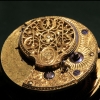Removing the balance...
-
Recently Browsing
- No registered users viewing this page.
-
Topics
-
Posts
-
See I wondered about this because Frei only lists one part for 18 size, no left or right options whereas they specify left and right for the other sizes. (I happen to be working on a grade 88) I recall seeing an old video of Elgin making laps and jewels in the factory (maybe you were the one who shared it) I have one very weird warming tool which has springy jaws that can open wide enough to hold this type of fork flat, and it swivels so you can position either side over the heat source. It works great for melting shellac on a firmly held fork EXCEPT can you guess what its fatal design flaw is?.... ....you cannot open the springy clamp once it has been heated because you would need to pinch them both between your fingers and you get a second degree burn. Genius.
-
The other thing that makes pallet forks like this interesting is or some of these interesting it when they're not level they don't fit well on the pallet fork warming tool and melting to shellac becomes a challenge. One of things you want to do when working on vintage pocket watches is accumulate broken pocket watches and swiped the jewels from them. Because as you're finding out the vintage jewels were probably not made out of Sapphire there are made out a Garnet and Garnet doesn't seem to hold up as well as shellac. Then the last little part about stones pointing in different directions doesn't make sense? There's always a left stone a right stone angles are different and they both have to be in the same direction. Although I once had a pocket watch command were somebody put one of the stones in backwards and surprisingly the watch ran. Then on some watches I done this with 12 size watches I've been able to swipe pallet stones from other 12 size not even the same company because they may have purchased or stones although Elgin I know at some point in time did make their own tools and had a separate section of the factory that made diamond grinding compound for all their lap and during work. Then when the company got liquidated the diamond division was sold the somebody else in the last I knew it was still running out there but not of course under the Elgin name. Still making diamond grinding compound. From the 1915 parts catalog you can see all 18 and 16 size pallet stones are basically identical. The difference is what they're made out of and one of them that they didn't policy side in stone probably in a seven jewel watch no one would ever see that anyway. Then you have a new or the old style determines its thickness and you would have of course right and left Then I'm attaching a PDF of Elgin escapement terminology is it is nice drawing to show you the difference between the left and right stones. Elgin watch company Escapement Terminology.PDF
-
The roller table is supposed to be held on by friction. If there is shellac under the roller table it might indicate that an improper repair had occurred prior to this as it would not be held in place with shellac. Sometimes overenthusiastic people re-shellacking the roller jewel will get shellac where it's not supposed to be. Then the picture of your roller it looks kind of damage? It doesn't quite look right it looks like somebody held with a pair of pliers or something? Then your balance wheel has limited quantity of screws? Not necessarily a problem but an indication of perhaps with the other things a prior bad repair perhaps as a guess.
-
Quartz watches like mechanical watches need to be serviced from time to time. In other words the lubrication with time we'll go bad and the watch Will not run or will not run very well in other words oh be slow because the gears are no longer turning properly due to bad lubrication. Then other things bad for quartz watches basically anything dust that normally wouldn't affect the mechanical watch will affect the quartz watch because the quartz geartrain has extremely little power. So looking at your movement up above more than likely you'd have to clean it and lubricated before the new circuit would work.
-
I be concerned if this roller table belongs ! Timegrapher will ask, where did you get this roller table or balance staff from? Regs
-






Recommended Posts